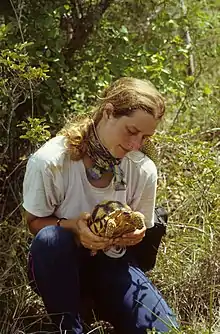Liz Howe
Liz Howe (27 October 1959 - 31 March 2019) was a British ecologist and herpetologist.[1][2] She is best known as one of the coordinators of a comprehensive field survey of the natural habitats of Wales, published in 2010.[3]
Liz Howe | |
|---|---|
 Liz Howe in Madagascar, with an angonoka (or ploughshare) tortoise, Astrochelys yniphora. | |
| Born | 27 October 1959 Kingstanding, West Midlands, England |
| Died | 31 March 2019 (aged 59) |
| Nationality | British |
| Alma mater | Queen Elizabeth College Bangor University |
| Scientific career | |
| Fields | ecology, conservation, herpetology |
| Institutions | Nature Conservancy Council Countryside Council for Wales Natural Resources Wales |
Early life and education
She was born Elizabeth Anne Pulford on 27 October 1959 in Kingstanding, West Midlands, England, daughter of Robert Pulford, an electrical engineer, and his wife, Margaret Davis. After attending Aldridge grammar school in Walsall she did an undergraduate degree at Queen Elizabeth College, University of London, where she won the Cheesman Prize for her studies of mammalian physiology. Her Ph.D. was awarded in 1985 from Bangor University for her work on the physiology of the ocellated skink, a lizard found in Italy, Greece and Malta.[1]
Career
After her Ph.D., she spent three decades working for the Nature Conservancy Council and its successor organizations in Wales, the Countryside Council for Wales and Natural Resources Wales. During this time she managed teams mapping vegetation throughout Wales, which was published in the book Habitats of Wales: A Comprehensive Field Survey, 1979-1997.[3] This has since been widely used as an evidence base for conservation management and for identifying potential Sites of Special Scientific Interest.[1] As a herpetologist she led reintroduction programs to conserve threatened species such as sand lizards[4] and natterjack toads.[5] She also reviewed the ecology and distributions of reptiles and amphibians in the book A New Natural History of Anglesey.[6] In her private time she and her husband restored a rare section of limestone pavement on their small holding near Marianglas, Anglesey, which was declared a Site of Special Scientific Interest shortly before her death.[7]
Personal life
Howe was an accomplished amateur flautist who promoted provision of music among young people. She was a committee member and secretary for the Friends of Gwynedd Youth Music and secretary for the Beaumaris Brass Band, for which she played euphonium.[1]
Publications
- R.J. Mitchell, S. Bailey, J.K. Beaton, P.E. Bellamy, R.W. Brooker, A. Broome, J. Chetcuti, S. Eaton, C.J. Ellis, J. Farren, A. Gimona, E. Goldberg, J. Hall, R. Harmer, A.J. Hester, R.L. Hewison, N.G. Hodgetts, R.J. Hooper, L. Howe, G.R. Iason,, G. Kerr, N.A. Littlewood, V. Morgan, S. Newey, J.M Potts, G. Pozsgai, D. Ray, D.A.Sim, J.A. Stockan, A.F.S Taylor and S. Woodward. (2014). The potential ecological impact of ash dieback in the UK. Joint Nature Conservation Committee Report No. 483.
- Howe, E.A. (2011). The application of Phase 1 level survey data for the conservation of Welsh habitats. In T.H. Blackstock, E.A. Howe, J.P. Rothwell, C.A. Duigan and P.S. Jones (Editors), Proceedings of a memorial conference for Dr. David Paul Stevens 1958-2007, Grassland Ecologist and Conservationist. CCW Staff Science Report No: 10/03/05, 168pp, Countryside Council for Wales, Bangor.
- T. H. Blackstock, E. A. Howe, J. P. Stevens, C. R. Burrows and P.S. Jones (2010). Habitats of Wales: A Comprehensive Field Survey, 1979-1997. University of Wales Press 240 pages | 100 color plates, 40 maps, 40 tables, 60 figures.
- T.H. Blackstock, Clare Burrows, E.A. Howe and J.P. Stevens (2007). Habitat inventory at a regional scale: A comparison of estimates of terrestrial Broad Habitat cover from stratified sample field survey and full census field survey for Wales, UK. Journal of Environmental Management 85(1): 224-3.
- L. Howe, T. Blackstock, C. Burrows, and J. Stevens. (2005). The Habitat Survey of Wales. British Wildlife 16:153-162.
- J.P. Stevens, T.H. Blackstock, E.A. Howe and D.P. Stevens (2004). Repeatability of Phase I habitat survey. Journal of Environmental Management 73(1): 53-9.
- P.S. Jones, D.P. Stevens, T.H. Blackstock, C.R. Burrows and E.A. Howe (2003). Priority Habitats of Wales – a Technical Guide. Countryside Council for Wales, Bangor.
- T. H. Blackstock, D. P. Stevens and E. A. Howe (1996). Biological components of Sites of Special Scientific Interest in Wales. Biodiversity and Conservation 5(7):897-920.
- T.H. Blackstock, J.P. Stevens, E.A. Howe and D.P. Stevens (1995). Changes in the extent and fragmentation of heathland and other semi-natural habitats between 1920–22 and 1987-88 in the Llyn Peninsula, Wales, UK. Biological Conservation 72(1):33–44.
- E. Howe (1990). Amphibians of Anglesey. In W. Eifion Jones (Editor), A New Natural History of Anglesey, Studies in Anglesey History (Helen Ramage, General Editor). Anglesey Antiquarian Society, Llangefni.
- E. Howe (1990). Reptiles of Anglesey. In W. Eifion Jones (Editor), A New Natural History of Anglesey, Studies in Anglesey History (Helen Ramage, General Editor). Anglesey Antiquarian Society, Llangefni.
- Howe. E. (1985). Reproductive and thermoregulation physiology in Chalcides ocellatus, the ocellated skink. Ph.D. Bangor University.
References
- "Liz Howe obituary". The Guardian. Retrieved 11 May 2019.
- "Last Word, BBC Radio 4, 10 May 2019". BBC. Retrieved 11 May 2019.
- Blackstock, Tim; Howe, Elizabeth; Stevens, Jane (2010). Habitats of Wales: A Comprehensive Field Survey, 1979-1997. University of Wales Press. ISBN 978-0708322574. Retrieved 11 May 2019.
- Aaron, Martin. "Rare sand lizards released in north Wales". BBC Blogs. BBC. Retrieved 11 May 2019.
- "Sand Lizard and Natterjack Toad Recovery Project 2011- 2014" (PDF). Natural Resources Wales. Retrieved 11 May 2019.
- Jones (ed.), Dr. W. Eifion (1990). A New Natural History of Anglesey. Anglesey Antiquarian Society. ISBN 0 9500199-6-8. Retrieved 11 May 2019.CS1 maint: extra text: authors list (link)
- "Public Notice, Natural Resources Wales". Bangor and Anglesey Mail (p. 32). 8 May 2019. Retrieved 11 May 2019.
